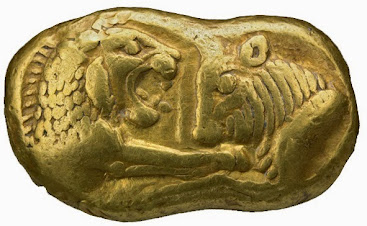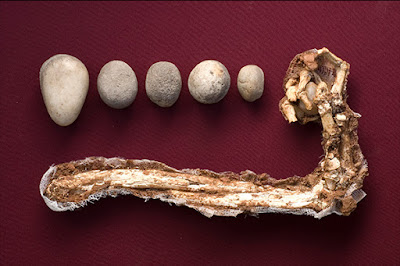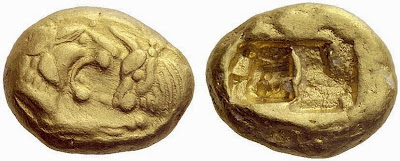 Croesus is credited with issuing the first true gold coins with a standardized purity for general circulation. Croesus is credited with issuing the first true gold coins with a standardized purity for general circulation. | Croesus was the king of Lydia from 560 to 547 BC until his defeat by the Persians. In Greek and Persian cultures the name of Croesus became a synonym for great wealth. His wealth came from the River Pactolus in which the King Midas washed his hands to rid himself of the 'Midas Touch'. |  |
 | Around 550 BC Croesus paid for the construction of the temple of Artemis at Ephesus, one of the Seven Wonders of the ancient world. Croesus is a legendary figure, but was an actual king who ruled from Sardis. |  |
 Marble column from the Temple of Artemis at Sardis Marble column from the Temple of Artemis at Sardis | 
Croesus claimed to be happy. Solon disagreed saying no one could be said to have lived a happy life until death, as the living dealt with an unknowable future. |  |
When Croesus learned of the Persians under Cyrus he sent to the Oracle at Delphi to divine whether he should wage war against the Persians. The oracle replied: "If Croesus goes to war he will destroy a great empire."

Tholos of Delphi | Pleased by this answer, Croesus met the Persian army at the Halys River. The battle was a draw. Cyrus pressed the attack, massacred Croesus’ cavalry by mounting his own on dromedaries (camels - whose scent frightened Lydian horses) and captured Croesus.  Arm of a soldier, killed in the battle between Croesus and Cyrus. He died clutching a sling stone in his hand. Arm of a soldier, killed in the battle between Croesus and Cyrus. He died clutching a sling stone in his hand. |  |
 | Croesus was dragged before Cyrus in chains. Cyrus ordered Croesus to be burned alive. Croesus called out for aid from Apollo. "O Solon! Solon! Solon!" Cyrus asked a translator what this meant and Croesus told the story of Solon’s visit, how no man can be counted happy until after his death, and how he was misled by the Oracle at Delphi. Cyrus was moved by this story and Croesus was released. He sent him to Delphi for an answer from the gods as to why he was betrayed. The answer came back that the Oracle had spoken only truth - a great empire had, in fact, been destroyed by Croesus – and it was not the fault of the gods if man misinterpreted the words. |

 | Greek literature for generations held up Croesus as a symbol of great wealth but one whose gold could not assure him happiness. It was in ancient Sardis in the time of Croesus that the first coins of pure gold and pure silver were struck, an important step leading to a monetary economy. |  |
 | Gold and silver are similar on a chemical level and are often found together forming an alloy known as electrum. Electrum wasn't always desirable for trade.
As coinage gained popularity, a way to standardize the purity of gold and silver was needed. The first technique of gold parting was invented: salt cementation. Salt cementation involves adding gold/silver alloy, some burnt clay or old brick dust, salt, and urine to moisten it. The mixture is sealed and then heated, but not hot enough to melt the gold – less than 1000°C. |  |
  | In about 24 hours, the gold will be nearly silver-free at around 90% purity or greater. When heated in the presence of silica and alumina (found in the clay/brick dust), salt breaks down to form hydrochloric acid and chlorine. The acidity in urine helps decomposition. The hydrochloric acid from this reaction interacts with the silver to create silver chloride, which separates from the gold. When that occurs, the reaction is volatile – which is why it's sealed.
After removing the gold, one can convert the silver chloride back into silver, giving you two separate, purified samples of precious metals for coins. Scholars argue that the gold standard of Croesus was introduced in stages, designed to recall the circulating electrum staters. Once a sufficient number had been recalled, the new light stater appeared. Though the light stater was produced for a longer period than the heavy stater, the light stater is actually the rarer coin. This NGC Gem MS light stater sold in April 2018 for $180k. |
 Croesus is credited with issuing the first true gold coins with a standardized purity for general circulation.
Croesus is credited with issuing the first true gold coins with a standardized purity for general circulation.


 Marble column from the Temple of Artemis at Sardis
Marble column from the Temple of Artemis at Sardis 













No comments:
Post a Comment